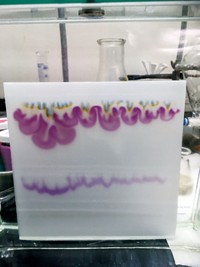Advertisement
Grab your lab coat. Let's get started
Welcome!
Welcome!
Create an account below to get 6 C&EN articles per month, receive newsletters and more - all free.
It seems this is your first time logging in online. Please enter the following information to continue.
As an ACS member you automatically get access to this site. All we need is few more details to create your reading experience.
Not you? Sign in with a different account.
Not you? Sign in with a different account.
ERROR 1
ERROR 1
ERROR 2
ERROR 2
ERROR 2
ERROR 2
ERROR 2
Password and Confirm password must match.
If you have an ACS member number, please enter it here so we can link this account to your membership. (optional)
ERROR 2
ACS values your privacy. By submitting your information, you are gaining access to C&EN and subscribing to our weekly newsletter. We use the information you provide to make your reading experience better, and we will never sell your data to third party members.
Materials
Newscripts
The art and science of making and breaking glass
by Sara Cottle
July 22, 2024
| A version of this story appeared in
Volume 102, Issue 22
Art meets science in Blown Away

Fans of the Netflix reality TV show Blown Away probably know more than the average person about transforming glass into all manner of creations. Four seasons in and the show has increasingly cut together footage with more technical details about the art and the science of glassblowing.
For Blown Away’s host Katherine Gray, it’s mostly about being attuned to the materials. “How you manipulate the material is a lot of science, but then what you are aiming to do with it is definitely more art,” she tells Newscripts.
The formulation of glass is a science. Today, Gray says that, at least in the US, only a few companies manufacture glass. For centuries, glassmaking was a tightly held secret. The formulation of certain colors was kept in even stricter confidence. For example, European cobalt blue shades likely resulted from a chemical composition different than that of the same shade in the US.
In Season 4 of Blown Away, contestants explain that using different colored glass affects their judgment of how the glass will react. For glassblowers familiar with one brand of glass and who work in one style or technique, changing to meet the challenge criteria on the show can test their skills.
Because the coefficient of expansion differs depending on the type of glass used, the expansion and contraction of the glass vary widely. Some colors are softer while others are stiffer, says Morgan Peterson, winner of Season 4 of Blown Away. “Depending if they’re transparent, opaque, white, or black, they all react differently to one another,” she says.
Peterson has dyslexia and wasn’t a big fan of geometry or math classes growing up, but she now uses those mathematic principles every day at work. “It’s much more creative for me,” Peterson says. “The way my brain works, I’m able to see it visually as opposed to writing out a problem.” She hopes to work with some wild materials in her future work—maybe something with ultraviolet glass or even uranium.
The quirkiest thing about glass as a material, Gray says, is “the way it breaks.” Sometimes glass breaks in the hotshop while being shaped, after going into the annealing oven, or during finishing processes; sometimes it cracks in an unusual place, and everyone is left wondering why. Sounds like lab work.

A lesson in shattered glass
Many university science departments employ glassblowers; for some, it’s a centuries-old tradition. Robert Stairs, a retired professor of chemistry at Trent University, learned to blow glass at Cornell University in the 1950s after an incident left him unable to face the school’s glassblower a second time.
“I took a drawing of a complicated apparatus . . . designed to measure surface tension of air-sensitive liquids, to the glassblower,” Stairs writes in an email to Newscripts. “A couple of days later, I collected it . . . and set about cleaning it. Before I put it in the drying oven, I noticed a little water inside of it, so I gave it a shake—and threw it onto the floor!” Determined to get his research done without a second visit to the glassblower, Stairs taught himself glassblowing and had replaced the apparatus within a matter of weeks.
Please send comments and suggestions to newscripts@acs.org.





Join the conversation
Contact the reporter
Submit a Letter to the Editor for publication
Engage with us on Twitter